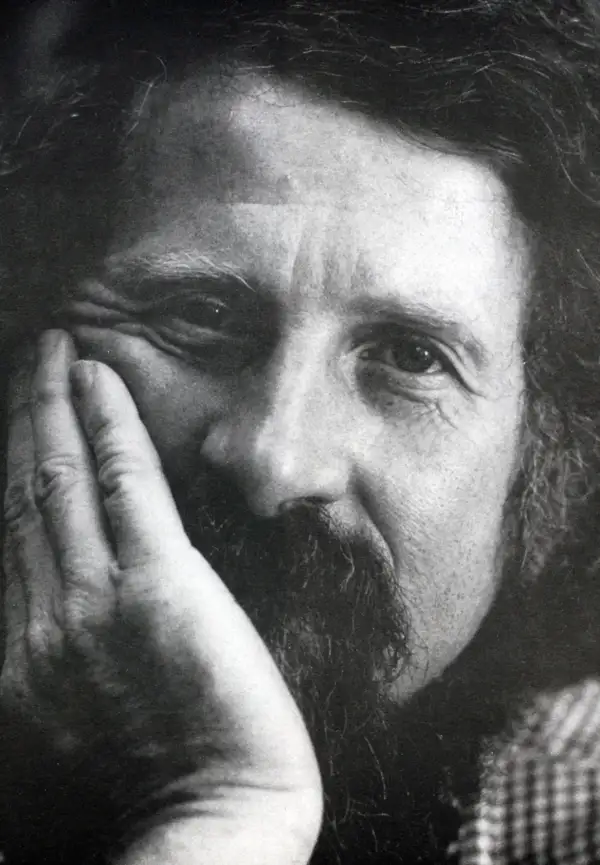Robert Dean Woodward
January 02, 2020
Robert Dean Woodward died the morning of Thursday, January 2, 2020, as he would have wanted: peacefully and quietly, sitting in a cozy chair and wrapped in a soft blanket, with his wife, Georgia, by his side. He died while watching the news on TV, with the latest Des Moines Register close at hand. Twelve days before, he had turned 83, celebrating his birthday with his immediate family. He and Georgia would have marked their 60th wedding anniversary on February 7.
A professor emeritus of journalism at Drake University and a former editor on the national/international desk at the Washington Evening Star, Bob was known to his students and colleagues as "our Bob Woodward." That moniker distinguished him from The Washington Post Watergate reporter of the same name.
As news of Bob's death spread — in the newspaper, TV news, and social media (a platform Bob had never fully embraced) — condolences poured in from family, friends, and former students and colleagues. They described him as a kind, gentle and compassionate spirit; a good listener; a supportive, inspirational advocate and mentor, with a great sense of humor and a knack for connecting students with internships and jobs; a brilliant, talented teacher, writer and editor, never without his felt-tip Flair red markers; a lover of history and collector of books and newspapers, which cluttered his office in Drake's Meredith Hall; a longtime adviser of the student newspaper, The Times-Delphic; and, in earlier years, a musician who, inspired by Woody Guthrie and Bob Dylan, played the banjo, guitar and harmonica and wrote more than 200 songs.
Bob was born on December 22, 1936, in Rodney, Iowa, to Evelyn Lettie Moranville Woodward, a schoolteacher from Jefferson, and Lawrence Franklin Woodward, a farmer from Rodney. The family first lived "in town" and later moved to a larger home a mile outside of Rodney, on the road to Onawa, near the farmland that had been in the Woodward family since the mid-19th century. Bob later was fascinated by his family's genealogy, which traced the Woodwards of England to Boston in the 1660s, then to Vermont and New York, and finally to Onawa and Rodney in the 19th century, and the Moranvilles from France, via Vermont, to Nebraska and Iowa.
Bob was a second of four children, born three years after the brother he looked up to and adored: Rex. Rex and Robert (which his mother called him) later became big brothers to their little sisters, Rosemary and Margaret, born a decade and more later. The four grew up in a house perched on a hill, amid the rich farmland and rolling landscape of the Loess Hills, next door to the schoolhouse they attended. Bob explored the hills and fields near the family farm and also camped and hiked as part of Boy Scouts. He worked as a counselor-in-training at a Boy Scout camp in southwestern Iowa and became an Eagle Scout.
Growing up, he attended the Rodney United Church of Christ, where his mother was a Sunday school teacher, ensuring her children attend. Church made an impression on Bob: Along with his mother's piano playing, church was one of his first introductions to music; he loved the old hymns, especially "Amazing Grace."
Over the years, Bob loved to visit Rodney and the church; in the 1980s, he contributed funds to help restore the stained glass windows there. Just days before his death, he had returned to see the church and the towns most significant to him — Jefferson, Mapleton, Smithland, Rodney and Onawa — on a special trip with his wife and daughter Meredith, visiting the family homestead and cemeteries where his parents, grandparents, aunts and uncles are buried.
Throughout his life, Bob found peace, quiet and spirituality not in church but outdoors, particularly on the prairies of Iowa and South Dakota, where he saw the cycle of life represented in the monarch butterflies that flitted among milkweeds and purple coneflowers.
In the late 1970s, he spent summers in the Black Hills of South Dakota, researching and writing about the history of Wind Cave National Park for a National Park Service publication. After he retired from Drake, he and Georgia counted monarchs at the Neal Smith National Wildlife Refuge, identified as a protected area for the migrating butterflies. He gave his granddaughters "Reporter's Notebooks" so they, too, could count monarchs alongside him. And he created a "Save the Monarch" website, which offered news of the monarchs' migration and his census counts.
Bob also loved the ocean. He and Georgia traveled each summer to Cape Cod, Massachusetts, where their two daughters, sons-in-law and four grandchildren gathered in Eastham near the national seashores. Bob would arise at 3 or 4 a.m. to take long walks on Marconi, Nauset Light and Coast Guard beaches, retracing the steps of Henry David Thoreau and Henry Beston, one time hiking as far as the site of Beston's "Outermost House." Bob collected rocks and observed birds and seashore life, recalling how a young man on the beach once called him the "embodiment of Thoreau." That quote is inscribed on a brick honoring Robert Woodward at Mass Audubon's Wellfleet Bay Wildlife Sanctuary nature center.
Bob and Georgia's other vacation spot was St. Louis, where they visited Busch Stadium nearly 50 times to see the Cardinals play. Bob had been a fan since childhood, when he listened to games on the radio, followed his favorite player, Stan Musial, and collected baseball cards. Bob and Georgia attended two World Series, including the one in 2004 where the Boston Red Sox ended the "Curse of the Bambino."
Sports was a running theme in Bob's life. When he lived and worked in Washington, he held season tickets to the Redskins. He became a fan of Indiana University basketball when he obtained a master's degree from there in 1971, pursuing African studies and learning Swahili. Earlier, at Smithland High School, he lettered in basketball and baseball.
A teacher in Smithland encouraged him to pursue college, but Bob's family could not afford the tuition. In 1955, he graduated as valedictorian of his class at Smithland High School and accepted a ROTC scholarship to enroll at the University of South Dakota that fall. He majored in journalism, served as editor of the student newspaper and won election as student body president after he asked a fraternity member to serve as his running mate, cornering the Greek vote. One adventurous summer, encouraged by his journalism professor, he traveled to Mexico City to see the sights. He hitchhiked back across Mexico and the United States, eventually catching a train to Onawa.
At the university, he met his future wife, Georgia Kaye Westra. As the story goes, he saw the speech and psychology major on stage as the lead in Wonderful Town, and told his friend, "That's who I'm going to marry."
Bob graduated from USD in 1959, and Georgia in January 1960. They married on February 7, 1960, in at First Methodist Church in Sioux Falls, South Dakota, and immediately headed to Indianapolis for Bob's U.S. Army training. They lived in a Quonset hut for two months, then traveled to Fort Belvoir, Virginia, where Bob served in the Army for two years, working in the public relations office. In 1962, he received an honorable discharge as a first lieutenant and the Army Commendation Medal for meritorious service.
With the goal of landing a full-time job in journalism, Bob started working part time as a sports copy editor at The Washington Post, a copy editor at the Evening Star and a public relations writer at George Washington University. A colleague suggested he apply to the Evening Star, and he landed a job there as a copy editor, eventually moving to the national desk. Bob befriended and edited the stories of many talented journalists, including the columnist Mary McGrory.
Later in life, he recalled this heyday of Washington journalism and politics, including the time President Nixon visited the newsroom, searching for one of his nemeses, declaring, "Where's McGrory?" Bob was conveniently positioned for the unfolding of incredible news events in the 1960s, including the Rev. Martin Luther King Jr.'s "I Have a Dream Speech" and the assassinations of John F. Kennedy, Robert Kennedy, and King. He recalled sitting on a hill in Washington, watching a parade of dignitaries — including Winston Churchill — driving by to attend JFK's funeral.
While living in Alexandria, Virginia, Bob and Georgia welcomed their two daughters: Meredith in 1963 and Allison in 1967. They lived on King Street, in an old brick house next to the George Washington Masonic National Memorial.
Interested in pursuing a college teaching career, Bob answered an ad in Editor & Publisher for a journalism position at Drake University. Bob started at Drake in 1972, as the Watergate story was unfolding, leading students to joke about having Bob Woodward as their professor.
Upon his death, the School of Journalism and Mass Communication posted this about Professor Woodward, "a beloved faculty member," who taught from 1972 to 2004 and served as the Ellis and Nelle Levitt Distinguished Professor of Journalism:
"Professor Woodward taught generations of SJMC students journalism history, reporting and editing. He also taught Honors classes and was longtime Times-Delphic adviser. He was a political junkie, an early and enthusiastic explorer of the Internet world, and a Monarch butterfly expert. Known affectionately as 'Woody' by his students, Woodward won the University’s top teaching and advising honors and received the Drake Medal of Service in 2006."
In the months before his death, Bob watched the media cover the Iowa caucuses, which he had researched and involved journalism students in reporting since 1976. In classes, national conferences, articles, and on C-Span, he would recall the fateful year when Jimmy Carter surprisingly won the caucuses, eventually becoming president, an event that led to the media and politicians visiting Iowa every four years.
Bob loved history, and that carried through to the houses in which he and Georgia lived, in both Virginia and in Iowa. After living in Des Moines for a year, they purchased a mid-19th-century Victorian house in Altoona, Iowa, in 1973. It was built by one of the town's founders, Thomas E. Haines. Bob and Georgia were avid antique collectors; in particular, Bob loved books and anything related to Abraham Lincoln. He also loved planting flowers in the yard: purple coneflowers and milkweeds to attract monarchs, and, over the years, thousands of tulips and lilies, some of which his daughters carried in their wedding bouquets.
Bob leaves his wife of nearly 60 years, Georgia; two daughters and sons-in-law, Meredith Woodward King and David King of Acton, Massachusetts, and Allison Woodward-Chartier and Dennis Chartier of West Des Moines; three granddaughters — Kate Chartier, Natalie Chartier and Madeline Woodward King — and a grandson, Andrew Woodward King; a sister and brother-in-law, Rosemary and Les Meineke of Menomonee Falls, Wisconsin; and a sister-in-law, aunt, cousins, nieces and nephews. He was preceded in death by his parents, Lawrence Woodward and Evelyn Moranville Woodward; his older brother, Rex Woodward; and his youngest sister, Margaret Pelkey.
Robert Dean Woodward will be buried in Little Sioux City Township Cemetery near Smithland and Rodney, next to his father and paternal grandparents, underneath an evergreen tree.
In lieu of flowers, memorial contributions may be sent to Drake University Advancement, 2507 University Ave., Des Moines, IA 50311-4505, indicating the Robert Woodward Scholarship, or you may contribute online at https://alumni.drake.edu/giveonline (select "Other" in the pull-down menu and write in Woodward Scholarship). Or you may contribute to Save Our Monarchs Foundation, P.O. Box 390135, Minneapolis, MN 55439, https://www.saveourmonarchs.org/.
--30--





Paul Fanlund
01/11/2020
Bob Woodwards greatest gift is how he made every student on his long journey in teaching feel special. I was in Bobs first class on his first day at Drake in 1972, and he influenced my life and that of my eventual wife, Lari Marner, also a journalism grad, in ways both personal and professional that are impossible to easily summarize. The altruism he demonstrated through his teaching is something that stayed with me and has always inspired me. We would have liked to have been there to honor him at Meredith Hall, but weather prevents that. Our sincere condolences to Georgia, Meredith and Allison.
David C Elliott
01/09/2020
Professor Woodward fundamentally changed my life. He was intrinsically Socratic in his teaching style and required me to think. Being his student during Watergate era was a remarkable experience that I treasure. I regret not seeing more of him in recent years. It is my loss.
Julie Herman Darnold Atkins
01/08/2020
My deepest sympathy to the family of Prof. Woodward who was probably my most important mentor along the way. I know I was one of many, but that was thing, he never made you feel that way. Drake J student class of 81
Kim Havener
01/07/2020
So very sorry! I remember Bob from high school. He was always kind and had a great sense of humor. I use to love spending the night with Allison. He will be missed by many ?
Marti Kline
01/07/2020
Never met anyone who didn't like and admire Bob Woodward. He was a valued mentor, friend and inspiration to me when I was publisher of the Altoona Herald. He was a legend ... and will always be remembered. Special thoughts to you, Georgia, and your family.
Judi Webb
01/06/2020
Georgia and family,
I was sorry to hear of Bob's passing. My deepest condolences to all of you.
Eldon Weber
01/05/2020
He was a great Smithland school friend where he and his brother Rex played baseball and basketball with me. He was very well liked and a real friend of our family! Wish I could have visited with him in his later years! My family is also buried in the Smithland Cemetery.
Bob 'Scoop' Anderson BFA '74
01/05/2020
Always enjoyed and appreciated his views or suggestions. They worked for photographers, too. Almost changed majors. He and those of his ilk will always be remembered and missed.
David Vawter
01/05/2020
Toni and I will have your family in our thoughts